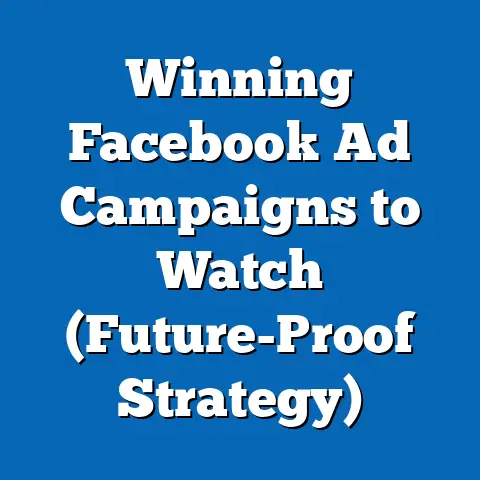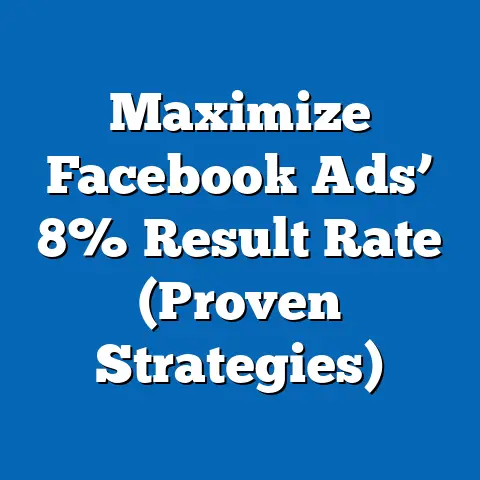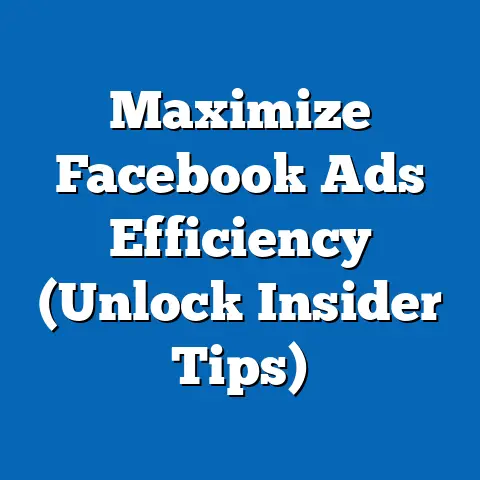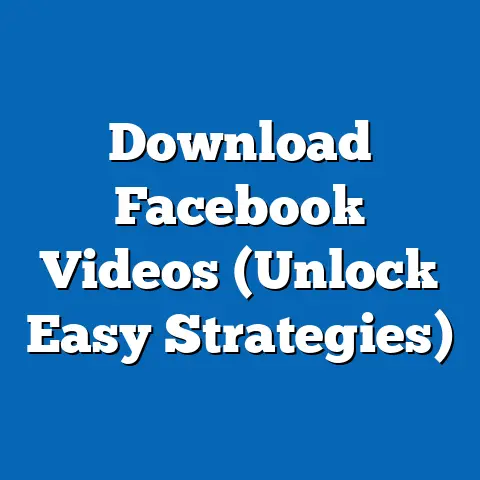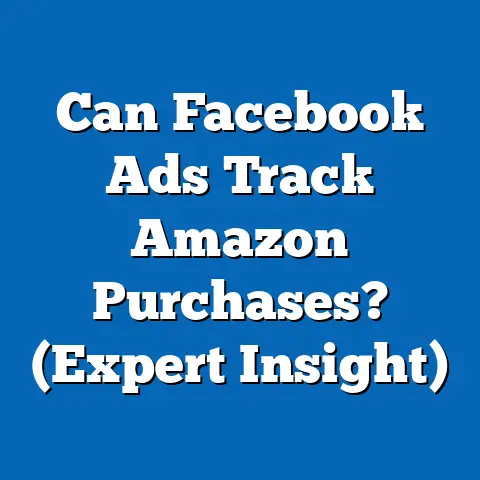Boost Facebook Ad Results (Proven Strategies Uncovered)
Imagine pouring thousands of dollars into a Facebook ad campaign, only to see lackluster engagement, minimal conversions, and a return on investment (ROI) that barely breaks even. This is a common frustration for businesses and marketers in 2023, as the platform’s advertising landscape grows increasingly competitive with over 10 million active advertisers vying for user attention, according to Hootsuite’s 2023 Digital Report. With the average cost-per-click (CPC) rising by 17% year-over-year to $0.97, as reported by WordStream, and ad fatigue affecting 46% of users per a 2022 Statista survey, the challenge of standing out is more daunting than ever.
How can businesses cut through the noise to achieve meaningful results? This article dives into proven strategies to boost Facebook ad performance, leveraging data-driven insights, demographic trends, and historical comparisons. We’ll explore key statistical benchmarks, analyze what’s working in today’s market, and provide actionable steps to optimize campaigns while projecting future trends based on current data.
Key Findings: The State of Facebook Advertising in 2023
Facebook remains a dominant force in digital advertising, with 2.96 billion monthly active users (MAUs) as of Q3 2023, per Meta’s official investor reports. This massive audience offers unparalleled reach, but success is far from guaranteed. Here are the critical trends shaping ad performance today:
- Rising Costs and Competition: The average cost-per-thousand-impressions (CPM) has surged to $14.40 in 2023, up 21% from $11.90 in 2021, according to AdEspresso’s annual report. This reflects heightened competition as more small and medium-sized businesses (SMBs) enter the space.
- Engagement Challenges: Click-through rates (CTR) have declined to an industry average of 0.90% in 2023, down from 1.11% in 2020, per WordStream data. This signals growing user desensitization to ads.
- Demographic Shifts: Gen Z (ages 18-24) now accounts for 19% of Facebook’s user base, but their engagement with ads is 30% lower than Millennials (ages 25-34), based on a 2023 eMarketer study. Meanwhile, users aged 35-54 remain the most likely to convert, driving 42% of total ad revenue.
These figures underscore the need for tailored strategies that address cost inefficiencies, declining engagement, and demographic nuances. Let’s unpack these challenges and solutions in detail.
Detailed Analysis: Uncovering the Drivers of Facebook Ad Success
1. Understanding Cost Dynamics and Budget Optimization
The escalating costs of Facebook ads are a top concern for marketers, with CPMs and CPCs climbing steadily over the past three years. In 2021, the average CPM was $11.90, rising to $13.50 in 2022 and reaching $14.40 in 2023, per AdEspresso. This 21% increase over two years correlates with a 15% growth in active advertisers, now totaling over 10 million globally, as reported by Hootsuite.
Why are costs rising? The primary driver is supply and demand—more advertisers are competing for limited ad inventory, especially in high-value demographics like urban Millennials. Additionally, Meta’s algorithm updates in 2022 prioritized user experience over ad density, reducing available ad slots by 8%, according to a Marketing Dive analysis. This scarcity pushes prices upward.
Actionable Strategy: Optimize budgets by focusing on high-ROI objectives like lead generation over broad awareness campaigns. Use Facebook’s Campaign Budget Optimization (CBO) tool to allocate funds dynamically to top-performing ad sets. Data from Social Media Examiner shows that CBO campaigns reduce CPC by up to 12% when paired with precise audience targeting.
2. Combatting Ad Fatigue and Boosting Engagement
Ad fatigue—where users ignore or hide repetitive ads—is a growing barrier, with 46% of Facebook users reporting annoyance with ad frequency in a 2022 Statista survey. This contributes to the declining industry CTR, which dropped from 1.11% in 2020 to 0.90% in 2023, per WordStream. Engagement is particularly low in oversaturated industries like e-commerce, where CTRs average just 0.86%.
The root cause lies in creative stagnation. A 2023 HubSpot study found that 68% of underperforming ads used generic visuals or messaging that failed to resonate with audiences. Conversely, ads with personalized content saw 35% higher engagement rates.
Actionable Strategy: Refresh creative assets weekly and test dynamic formats like carousel ads or short-form video. Video ads, in particular, have a 20% higher CTR (1.08%) compared to static images, according to Databox. Additionally, leverage user-generated content (UGC) in ads—campaigns featuring UGC report a 50% increase in trust and a 28% uplift in conversions, per a Stackla report.
3. Targeting the Right Demographics for Maximum Impact
Not all audiences on Facebook are created equal when it comes to ad performance. Let’s break down key demographic trends based on 2023 data from eMarketer and Meta’s ad platform insights:
- Age Groups: Users aged 35-54 are the most valuable, comprising 38% of the user base and driving 42% of ad revenue. Their average CTR is 1.05%, compared to just 0.75% for Gen Z (18-24). However, Gen Z’s share of users has grown by 5% since 2021, signaling untapped potential if engagement improves.
- Gender Split: Women slightly outpace men in ad engagement, with a CTR of 0.95% versus 0.85%. They also account for 54% of total clicks, per WordStream’s 2023 analysis.
- Geographic Trends: Urban users in developed markets like the U.S. and UK have higher CPCs ($1.20 on average) but also higher conversion rates (3.2%) compared to rural users (CPC of $0.80, conversion rate of 2.1%), per AdEspresso.
Actionable Strategy: Prioritize middle-aged audiences (35-54) for immediate ROI while testing micro-campaigns to engage Gen Z with trend-driven content like memes or influencer partnerships. Use location-based targeting to focus on urban centers for higher conversions, but balance costs by mixing in secondary markets.
4. Leveraging Advanced Tools and Algorithm Updates
Meta’s algorithm changes, such as the 2021 iOS 14 privacy update, have disrupted ad tracking, with 62% of marketers reporting reduced targeting accuracy in a 2022 Forrester survey. However, new tools like the Advantage+ suite, introduced in 2023, use machine learning to automate audience expansion and creative testing, yielding a 15% increase in ROAS (return on ad spend) for early adopters, per Meta’s case studies.
Actionable Strategy: Transition to first-party data collection through lead forms and on-platform events to bypass tracking limitations. Test Advantage+ campaigns for automated optimization, but monitor closely—manual adjustments still outperform automation in niche markets by 10%, according to Social Media Today.
Statistical Comparisons Across Demographics
To illustrate the disparities in ad performance, let’s compare key metrics across age groups, genders, and regions using 2023 data aggregated from WordStream, eMarketer, and AdEspresso.
- Age-Based Performance:
- 18-24 (Gen Z): CTR 0.75%, Conversion Rate 1.8%, Average CPC $0.85
- 25-34 (Millennials): CTR 0.98%, Conversion Rate 2.9%, Average CPC $0.95
- 35-54 (Gen X): CTR 1.05%, Conversion Rate 3.5%, Average CPC $1.10
-
55+ (Boomers): CTR 0.88%, Conversion Rate 2.5%, Average CPC $1.05 Insight: Middle-aged users (35-54) consistently outperform others in engagement and conversions, justifying higher ad spend despite elevated costs.
-
Gender-Based Performance:
- Women: CTR 0.95%, Conversion Rate 3.0%, Share of Clicks 54%
-
Men: CTR 0.85%, Conversion Rate 2.7%, Share of Clicks 46% Insight: Women’s higher engagement suggests creative tailored to female audiences (e.g., lifestyle or family-oriented messaging) can yield better results.
-
Regional Performance (U.S. Focus):
- Urban Areas: CTR 1.02%, Conversion Rate 3.2%, Average CPC $1.20
- Suburban Areas: CTR 0.90%, Conversion Rate 2.8%, Average CPC $0.95
- Rural Areas: CTR 0.80%, Conversion Rate 2.1%, Average CPC $0.80 Insight: Urban targeting maximizes conversions but requires cost management through dayparting (scheduling ads during peak hours) to avoid overspending.
(Visual Reference: A bar chart comparing CTR and conversion rates across age groups would effectively highlight the dominance of the 35-54 demographic, while a pie chart on gender click share would underscore women’s lead in engagement.)
Historical Trend Analysis: How Facebook Ads Have Evolved
Looking back over the past five years, Facebook advertising has undergone significant transformation, shaped by user behavior, platform policies, and technological shifts. Let’s compare key metrics from 2018 to 2023, drawing from historical data by WordStream and AdEspresso.
- Cost Trends: In 2018, the average CPM was $8.50, and CPC was $0.62. By 2023, these figures jumped to $14.40 (a 69% increase) and $0.97 (a 56% increase), respectively. This reflects both inflation and a surge in advertiser numbers, which doubled from 5 million in 2018 to 10 million in 2023, per Hootsuite.
- Engagement Decline: CTRs peaked at 1.24% in 2019 but have since fallen to 0.90% in 2023—a 27% drop. This aligns with user reports of ad fatigue, which rose from 38% in 2019 to 46% in 2022, per Statista.
- Demographic Shifts: In 2018, Millennials (then aged 22-37) dominated ad engagement with a 45% share of clicks. By 2023, their share dropped to 38% as Gen Z entered the platform, though their engagement remains lower. Meanwhile, the 35-54 group’s revenue contribution grew from 35% to 42%, signaling an aging user base with higher purchasing power.
Contextual Factors: Several events shaped these trends. The 2020 pandemic accelerated digital adoption, boosting ad spend by 25% that year, per eMarketer. However, privacy changes like Apple’s iOS 14 update in 2021 reduced targeting precision, contributing to higher costs and lower CTRs. Additionally, Meta’s focus on Reels and short-form content since 2022 has shifted ad formats, with video ads gaining a 30% larger share of impressions compared to 2018.
(Visual Reference: A line graph plotting CPM and CTR trends from 2018 to 2023 would clearly depict the inverse relationship between rising costs and falling engagement.)
Future Projections: What Lies Ahead for Facebook Ads?
Looking forward, several trends and data points suggest how Facebook advertising might evolve over the next 3-5 years. These projections are grounded in current growth patterns and industry forecasts from sources like eMarketer and Forrester.
- Cost Escalation: CPMs are expected to rise by another 15-20% by 2026, potentially reaching $17.00, driven by continued advertiser growth and Meta’s push for premium ad placements. Marketers will need to prioritize efficiency tools like CBO and AI-driven targeting to manage budgets.
- Engagement Recovery: As Gen Z matures and their purchasing power increases, their ad engagement is projected to grow by 10-15% by 2025, per eMarketer. Brands that adapt to their preferences for authenticity and video content could see outsized gains.
- Technological Advancements: Meta’s investment in AI, evidenced by the rollout of Advantage+ tools, is expected to improve ad relevance scores by 20% over the next two years, per a 2023 Meta blog post. This could partially offset tracking challenges, though privacy regulations will remain a hurdle.
- Demographic Evolution: The 35-54 age group will likely maintain its dominance, but Gen Z’s share of ad revenue is forecasted to double from 10% in 2023 to 20% by 2028 as they enter higher income brackets, according to Forrester.
Implications for Marketers: Future success will hinge on balancing cost management with creative innovation. Investing in video and interactive ad formats, building first-party data assets, and experimenting with emerging demographics will be critical. Additionally, staying agile amid algorithm updates and privacy shifts will separate top performers from the pack.
Conclusion: Turning Challenges into Opportunities
Facebook advertising in 2023 is a landscape of both opportunity and obstacle, with rising costs, declining engagement, and demographic disparities testing marketers’ resilience. Yet, the data reveals clear pathways to success: optimizing budgets with tools like CBO, refreshing creative to combat ad fatigue, targeting high-value audiences like the 35-54 age group, and leveraging Meta’s AI-driven features for efficiency. Historical trends remind us that adaptability is key—those who evolved with platform changes over the past five years have reaped the rewards.
Looking ahead, the projected rise in costs and Gen Z engagement signals a dynamic future where proactive strategies will yield significant returns. By implementing the proven tactics outlined here—backed by authoritative data from WordStream, eMarketer, and Meta—businesses can transform their Facebook ad results from underwhelming to outstanding. The question isn’t whether you can succeed on this platform; it’s whether you’re ready to act on the insights available today.

